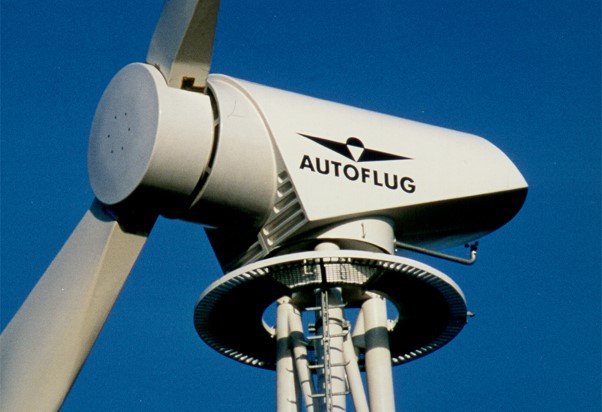Installations that use wind energy are classified by the position of the rotation axis as the ones of horizontal axis and vertical axis.
The most widely spread are horizontally axial installations. This happened due to the rapid development of military aviation and shipbuilding in the beginning of 20-s of XX century. To finance the development of a theoretical base of aircraft and ship propellers, huge funds were allocated in the leading countries of the world such as USA, UK, Germany, Japan and the USSR. This funding has continued for nearly 80 years up to present times. The type of a modern wind turbine has been dictated by these circumstances, since impellers have been a byproduct of theoretical and practical development of propellers.
Nowadays, anyone who is interested in windmills will say that the efficiency of horizontal axis impeller (blade wind turbine) is within 0.6 – 0.7, and «clumsy» vertical axis one- up to 0.39.
However, the research of the author of this article refutes these parameters. Actually, the theoretical efficiency factor of a blade wind turbine, according to one of the founders of Fluid Dynamics E. Zhukovsky, is 0.593.
The real efficiency of a modern wind turbine, according to independent experts, is 0.42 – 0.43, which is very close to the value of 0.39 of a vertical axis wind turbine.
But, according to the author of this article, the unenviable fate of vertical axis rotors has been determined by their impracticality, especially in aviation.
To determine the correct shape of propellers and to test them in laboratory conditions, wind tunnels have been created. Theoretical errors in the simulation in this case are reduced to a minimum. Of course, the propeller is easy to install in the wind tunnel for the test. But how to test the vertical axis rotor in the same tube, which has a cross-section of not a circle but a square or rectangle? Should we create a rectangular parallelepiped for aerodynamic tests? It would be very expensive! Wind tunnels were created not for testing of wind turbines but to improve propellers of military planes.
For example, venting of the model of Savonius rotor in Kuchynski wind tunnel produced the highest rate of utilization of wind energy equal to 18%, while in the wind tunnel of aerodynamic institute in Berlin WTU, the results were 24% (See the Forschungen aus dem Gebite des Ingenieurwesens, June 1931, B . 2, number 6).
From the point of view of hydrodynamic modeling, there was made another mistake. In reality, during rotation of a plane propeller, or fanning of windmill blades with the wind, the air is not compressed, as in tunnel tests. From this point of view, all laboratory experiments in modeling of blades were to be conducted in an incompressible liquid medium. In this case you can separate simulation and testing of a blade device in a pipe, and test a rotor in a rectangular channel. I am confident that the efficiency of these two types of wind turbines will change significantly.
And so, let us go back to the comparison of blade and rotor windmills.
Blade wind generators
Aerodynamic shapes are fairly well developed. Their design and installation in a standalone mode, as well as their adaptation to existing electrical systems are not difficult from an engineering point of view. As their positive characteristics are widely known, I will focus more on the shortcomings.
The main drawback is their high position on the mast of a complex structure (up to 80 – 100 m above the ground). Large spread of blades limits their installation in centers of population. Large gyroscopic moment arising from the operation in strong winds, requires strengthening of the supports and the blade, especially where they connect with the axis of rotation. These circumstances lead to high cost of installation and, ultimately, to the high price of electricity.
Operating conditions of such windmills are created with a wind speed of 8 – 12 m / sec. Most frequent winds, especially in the UK, are within 5 – 8 m / sec. A detailed examination of the wind rose in the UK showed a very little occurrence of winds with speeds of 8 – 12 m / sec. Moreover, their duration is very small to be viable for industrial use. This means that windmills stay idle most of the time.
As can be seen from the graph below, the stabilization of the wind speed in open terrain happens at the height of more than 10 meters above the ground. Therefore, the distance from the ground to the lower level of the blades must be no less than 10m, and for the usage in the sea – not less than 22 m.
 It is practically impossible to attach such installations to any existing or projected building or structure, thus limiting their use in building complexes, unless it is a small, low-power windmill.
It is practically impossible to attach such installations to any existing or projected building or structure, thus limiting their use in building complexes, unless it is a small, low-power windmill.
10m From the point of view of aerodynamic modeling, large windmills are nonsense. They lost the relation to the object they were initiated by – a propeller.
Let’s try to examine the opposite problem. Anyone who understands and clearly sees the difference in shapes and parameters of flying machines, will not consider usage of windmill blade propellers with diameter of 50 – 60 m for a giant plane. An aircraft constructor would immediately tell that the giant aircraft must have a different shape of blades.
Vertical axis rotor windmills
Let us consider, for example, the Savonius rotor mentioned above in a vertical axial position. The efficiency factor of this rotor, according to aerodynamic tests in the 70s, is 0.39. The optimum speed of operating mode is 6 – 8 m / sec. If we use modern composite materials, we can significantly reduce the use of metal in its manufacturing. The supporting structure height will be significantly lower and the production cost – cheaper.
When fanning with the wind, the rotor rotates due to the difference of resistance to wind pressure (see chart 2). With increasing wind speed, apart from resistance to wind by the rotor configuration, there is the additional resistance caused by the vortex motion of air around the rotor. The higher the speed, the lower is the efficiency of the installation.
Scheme 2. Whirl around the rotor.
The kinetic energy of wind creates the same pressure at the top and bottom parts of the rotor. However, different resistance in the flow through the convex and concave forms of the rotor creates a rotary motion around the axis.
If we fence the domed part by the semi-circular shield, then the resistance to the wind at the top will clearly drop and rise. The front vortex flow will not touch the wind. If we place two rotors rotating in opposite directions in a protective housing, an additional positive effect will be achieved.
This principle is the essence of the patent of the author of the article (see Figure 3).
Figure 3.The principle of a dual rotor of the windturbine.
The formula of the invention
The wind energy installation containing two rotors with vertical axes of rotation, set in the shell equipped with the guiding device of a wind-vane type and fixed to the rotary platform. It is different in that the shell has a streamlined drop shape, bounded above and below by the flat elements, and the S-shaped air-intake blades of rotors symmetrically protrude from the body on both sides, and flat elements in front of the axes of rotation of the rotors have cut-offs.
This configuration will help to significantly improve the efficiency of the wind installation and to use a horizontally elongated rectangular plane for air intake at small heights.
The installation of a large-sized device on a hill will allow to lower the supporting part of the installation to ground level. The installation will allow to be used on upper technological floors of multi-floor buildings. In doing so, the effect of the horizontal rotor axis installation usage will be higher due to sail effect of a building façade.
The most important factor of the use of this facility is the fact that its the working mode is within the range of wind power of 3 – 8 m / sec, which increases its effectiveness on the territory of the UK, largely dominated by winds within this range.
The rotation of two rotors in the plant in opposite directions allows to summarize the number of turns in the windmill, which is very important for the power (electricity) generation.
A very important fact that as a result of counter-rotation of the rotors, the gyroscopic moment, which creates a big problem in a windmill blade, mutually extinguished.
Design calculations show that building of the installation of metal, especially of a big size, will be practically unprofitable. Only by use of modern composite materials, this product can ensure its competitiveness, as compared with traditional windmills.
Murat Khatukaev
Managing Director
Eco Fortis Ltd





